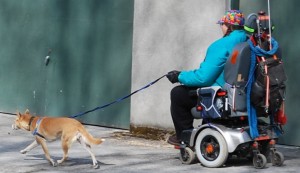 With Guest Chatter, Dr. Mary Lee Nitschke, CAAB
With Guest Chatter, Dr. Mary Lee Nitschke, CAAB
We’ve seen an increasing number of news reports about the problem of “fake” service dogs. It’s hard to know whether these problems really exist, whether there is an apparent increase in frequency or whether such cases have merely become more visible. Whatever the case, it’s generating a boat load of discussion and threats of legislation and more regulations. A proposed law in British Columbia will create standardized IDs to make it harder to pass off the family pet as a service dog (Click HERE for the story). A similar proposal was floated by Arizona’s governor who quickly dropped the idea after service dog owners complained it would make public access with their dogs more difficult.
We wanted to explore this topic in a CAAB Chat, and contacted our long-time friend, colleague and fellow CAAB Dr. Mary Lee Nitschke. Dr. Nitschke has been a service dog owner, handler, and trainer for quite some time and is the found of O.T.I.S. – Owner Trained Individualized Service Animals in Portland Oregon.
Even though one of us (Suzanne) consulted with the Delta Society for years on their service dog programs, as we talked with Dr. Mary Lee, we realized how much we didn’t know about service animals today, including what defines a service animal, and the options available for acquisition and training. The issue of public access is yet another component to this quite complex subject. For that reason, we concluded we’d need more than one CAAB Chat to discuss the intricacies of this timely topic.
In this first Chat on service animals (we’ll be talking primarily, but not entirely about dogs) we’ll start by tackling the thorny issue of what “defines” a service dog (and even if that’s possible!) Mary Lee suggests you take a look at “From Service Dog to Surfice Dog” at www.surfdogricochet.com and form your opinion as to whether Ricochet is a service dog or not. She’ll also tell you about her own harrowing experience when a restaurant patron threatened her client’s service-dog-in-training.
The definition problem is related to the various pathways through which dogs, and other animals, can become service animals. We’ll chat about agencies and alternatives for both acquisition and training. We’ll look at where the pathways intersect with human health care providers, and the issue of public access. You might not have thought about it, but although public access and the functionality of service animals for their handlers are almost inextricably intertwined, they are different issues.
We’ll end this chat with Dr. Nitschke’s recommendations for what any who is or wants to train service dogs should know and how behavior and training professionals can serve as resources in their communities when concerns about service animals and their access arise. These issues will likely only become more frequent in the future until existing laws and regulations catch up with what’s happening in the real world.
You won’t want to miss this intriguing Chat that we guarantee will leave you with much to continue talking about.
Couldn’t make the live chat? No worries, you can purchase the replay now for only $15.00 through Paypal. You do not need a Paypal account – you can pay with a credit card.

BEST VALUE – Join BEN!! Want access to ALL past and future CAAB Chat replays? Join Behavior Education Network and enjoy this and many more member benefits including exclusive BEN webinars EVERY month, weekly Biscuits (articles) on useful and important topics.
Not a member of BEN?
 Learn More and Join Today at www.BehaviorEducationNetwork.com
Learn More and Join Today at www.BehaviorEducationNetwork.com
Current BEN Members: Pro Members have unlimited access to all CAABChat replays through your direct access to BEN. Do NOT try to use your BEN credentials here. They will not work. Log into BEN HERE
Suggested Resources that will be mentioned in the Chat.
1. “A test for the evaluation of emotional reactivity in Labrador retrievers used for explosive device detection”. Sherman, B.L., et al. Journal of Veterinary Behavior, 2015, 10, 94–102.
Dr. Nitschke will comment on the evaluation procedures described in the research and if they are similar to what she looks for and attempts to evaluate in potential service dogs. Click HERE to read the abstract, and purchase paper if you wish.
2. “A revised taxonomy of assistance animals.” Parenti, L., et al., Journal of Rehabilitation Research & Development, 2013, 50, 745-756.. Read the Full Article HERE.
Good coverage of the complicated terminology used by different agencies or organizations – none of which are consistent with each other!.
Follow Us!